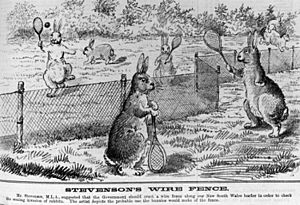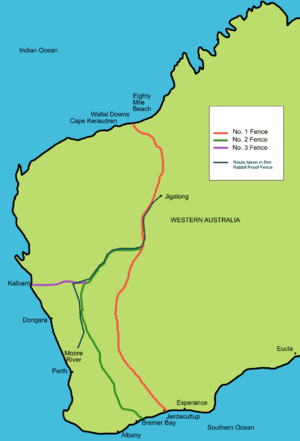Rabbit-proof fence facts for kids
The State Barrier Fence of Western Australia is a very long fence built a long time ago to protect farms. It was also known as the Rabbit Proof Fence. Its main job was to stop rabbits and other farm pests from the eastern parts of Australia from getting into the farming areas of Western Australia.
There are actually three fences in Western Australia. The first one, called No. 1 Fence, goes from north to south across the state. No. 2 Fence is smaller and further west. No. 3 Fence is even smaller and runs east to west. It took six years to build all these fences. When they were finished in 1907, the total length of the fences was about 3,256 kilometres (2,023 miles). Building each kilometre of the fence cost about $250 back then.
When it was completed in 1907, the No. 1 Fence was about 1,833 kilometres (1,139 miles) long. It was the longest fence in the world that was not broken up.
Contents
How the Fence Came to Be
Rabbits were first brought to Australia in 1788 by the First Fleet. But they only became a big problem after October 1859. That's when a man named Thomas Austin let go of 24 wild rabbits from England. He wanted them for hunting. He thought a few rabbits would not cause much harm. He also hoped they would make the new land feel a bit more like home.
But the rabbits had many babies very quickly. They spread fast across the southern parts of Australia. Australia was a perfect place for rabbits to grow in numbers. This was because they had almost no animals that hunted them (predators) there.
By 1887, farmers were losing a lot of money because of rabbit damage. The government of New South Wales offered a big reward of £25,000. This was for anyone who could find a new way to get rid of the rabbits. In 1901, a special investigation, called a Royal Commission, was held to look into the rabbit problem.
Building the Big Fence
The fence posts were placed about 3.7 metres (12 feet) apart. They were at least 10 centimetres (4 inches) wide. At first, there were three wires. They were placed about 10 centimetres (4 inches), 51 centimetres (1 foot 8 inches), and 94 centimetres (3 feet 1 inch) above the ground. Later, more wires were added. A barbed wire was put at about 102 centimetres (3 feet 4 inches). A plain wire was added at about 109 centimetres (3 feet 7 inches). This made the fence also stop dingoes and foxes. Wire netting was also attached to the fence. It went about 15 centimetres (6 inches) into the ground.
The fence was built using different materials. This depended on the weather in the area and what wood was available. At first, posts were made from Salmon gum and Gimlet trees. But these woods attracted termites, which are tiny insects that eat wood. So, these posts had to be replaced. Split white gum wood was one of the best types used. Other woods like Mulga, Wodjil, native pine, and tea-tree were also used. They used whatever wood they could find close to where the fence was being built. If there was no wood, iron posts were used instead. Most of the building materials had to be moved hundreds of kilometres. They were brought from train stations and ports by teams of bullocks, mules, and camels.
Building the fence started in 1901 with private companies. But in 1904, the government's Public Works Department took over. Richard John Anketell was in charge. He had a team of 120 men, 350 camels, 210 horses, and 41 donkeys. Anketell was responsible for building most of the No. 1 Fence. He also surveyed the last 113 kilometres (70 miles) of it.
Keeping the Fence Working
Alexander Crawford took over looking after the fence from Anketell. He stayed in charge until he retired in 1922. The area inside the fence to the west became known as "Crawford's Paddock." At first, people called boundary riders checked the fence by riding bicycles. Later, they rode camels. But it was hard to check the fence well from high up on a camel. In 1910, a car was bought for checking the fence. But its tires often got flat. It was found that the best way to check the fence was using small carts called buckboard buggies. These were pulled by two camels.
Camels were very important for carrying supplies, especially in the north. In the south, camels pulled wagons with supplies for the riders. Camels were perfect for this job because they could go a long time without water. Many people believe that the fence could not have been built or kept working without the help of camels.
Besides Crawford, there were four sub-inspectors. Each one was in charge of about 800 kilometres (500 miles) of fence. There were also 25 boundary riders. They regularly checked sections of the fence that were about 160 kilometres (100 miles) long. In the north, because of some dangers, a 480-kilometre (300-mile) part of No. 1 Fence was checked by riders working in pairs.
Crawford also had to get rid of any rabbits that managed to get past the fence. In the first year after the fences were finished, groups of rabbits were found and killed inside the fence. This happened in places like Coorow, Mullewa, and Northampton.
In the 1950s, a disease called myxomatosis was introduced to control the rabbits. After this, the rabbit-proof fence became less important.
Other Fences in Australia

The Darling Downs-Moreton Rabbit Board fence is another rabbit fence. It runs along part of the border between Queensland and New South Wales.
See also
 In Spanish: Barrera a prueba de conejos de Australia para niños
In Spanish: Barrera a prueba de conejos de Australia para niños



